Yunnan Province (pop 46 million)
Yunnan is in the far SW of China bordering on Myanmar, Thailand. Laos (at the Golden Triangle) and NW Vietnam.
With the highest diversity of any province in China, both in people and landscapes, it has become a destination for foreigners and the domestic tourist industry. More than half of the country’s ethnic minority groups reside here. The land varies from dense jungle sliced by the Mekong River in the south, rice terraces in the southeast and snow-capped mountains as you edge towards Tibet.
The main attractions are Tiger Leaping Gorge in the far west near Lijiang and Dali, a backpacker haven.
Transportation links are good so getting around is a breeze. To escape China’s winter chill, head to Kunming, the city of eternal spring.
History. Because of its remote location, harsh terrain and diverse ethnic makeup, Yunnan was once considered a backward place.
The early Han had tentative power forging southern Silk Road trade routes to Burma. From the 7th to the mid-13th centuries, two independent kingdoms, the Nanzhao and Dali, ruled and dominated the trade routes from China to India and Burma. It wasn’t until the Mongols swept through the southwest that Yunnan was finally integrated into the Chinese empire. Still isolated, it remained an isolated frontier region, more closely aligned with Southeast Asia than China.
Today, Yunnan is a strategic jumping point to China’s neighbors and has modernized.
Climate. With its enormous range – 76.4m above sea level near Vietnam to 6740m in the Tibetan plateau (average 2000m), Yunnan has a diverse climate. In the northwest around Shangri-la, winters reach -12°C, but in Xishsuangbanna, you can wear short sleeves in January. Dali has an ideal year-around climate with temperatures never dipping below 4°C in winter or above 25°C in summer. Kunming likewise is pleasant year around.
Language. In addition to Mandarin, languages belong to the Tibeto-Burman family or the Sino-Tibetan family.
More observations on China.
I never get tired of trying to figure out how and why people behave and think the way they do. This all stems from the five times I worked in the Canadian Arctic – the Inuit’s behaviour (over almost everything) baffled me and it took a long time to unravel some of the puzzles. It was amazing. Traveling in India sparked the same interest. It makes travel so much more interesting.
Read the post I did on spitting behavior. After minimal research, I think I have a pretty good idea what is going on. To paraphrase: they think swallowing spit is gross and view spitting as an involuntary, necessary behavior (akin to vomiting) and that is reflected in the language which differentiates spitting and vomiting (the same word) from spitting at someone to insult them, a voluntary action (and a different word). It is thus ingrained in their culture and accepted as normal, ordinary behavior. Go figure! It may have something to do with all the pollution and a means to clear their lungs, but I don’t think so.
Their disrespect of other’s personal space is also interesting. Chinese don’t walk in exactly straight lines and instead meander slightly. They walk in pairs, threesomes, foursomes abreast on sidewalks. They often walk slowly as if in no hurry. They walk in front of you cutting you off. They don’t wait until the people exiting the subway or bus are all off before trying to get on. They stand anywhere, not off to the side. They never line up on one side of an escalator allowing the climbers to move beside them. They don’t walk on the right side on a sidewalk so that everybody can move more easily. They never hold the door open for others. Some will give up seats to old people, women with babies, or pregnant women, but it is by no means common. Then the recipient rarely acknowledge your graces. No please and thank-you here. They constantly step on the back of your shoes. I didn’t think flip-flops put my feet in danger until China. Toes are stepped on regularly. Maybe it is because there are so many people, one becomes immune to others, but I don’t think so. It must be some cultural thing that I am unable to explain.
In that vein of respecting other’s space, something that I find more irritating than anything is that Chinese don’t close their mouth when chewing and make as much noise as possible. Sitting next to me in this McDonalds having a coffee in Kunming airport are a 20-something attractive woman, a mid-60s year old businessman in a suit and 15 feet away another young woman. I can hear them all eat easily. Men in general are much louder. This behaviour is not isolated to China and seems universal throughout SE Asia. I talked to the businessman – and he is from Thailand and when I ask him his age, he is 54, a French teacher at the University of Chang Mai!
I don’t understand how Chinese can tolerate the perpetually oppressive, grey skies. These are not clouds – you never see those either. I can only remember seeing blue sky three times in a month – one day in Beijing, on the way to Datong and one day on the Yangzi. Even the west coast of British Columbia in its rainy winter has days like this when it is raining heavily. Otherwise we see clouds and/or blue sky. I wonder what the incidence of SAD – seasonal affective disorder – is in China? The only reasonable explanation is smog and pollution. They naively call is fog. It can’t be good for health – I wonder what the incidence of respiratory disorders are in China.
China is surprising easy to travel in. C-trip makes booking flights, trains and hotels easy. Hostel world and C-trip work great for hostels and hotels respectly. But often there is no need to book in this the off-season. My Lonely Planet is my constant companion. Place names have mandarin translations. Announcements and signs in airports and trains are usually in English. When you look lost, somebody comes to help. My small English/Mandarin phrase book is handy – all you really need is ‘take the bus/taxi’, ‘train station, bus station, airport’, and some foods so that you can order in a restaurant. Xie Xie helps. A smile goes a long ways – and usually gets one back. Transportation, accommodation and food is all cheap.
Getting wi-fi without a mobile phone is impossible in airports and Starbucks as the password is sent over the phone.
The taxi to Sanxia Airport in Yichang takes over an hour and cost 100¥. I wanted to take a taxi to a bus for the airport but some things become too complex to save 60¥. I have 3 flights from Yichang. There was a 20-minute stop in Chongqing (oddly had to deplane and board again). In the airport, a small espresso coffee was over $9, a juice over $6. Around the corner I bought a large Pepsi for 60¢, less than half the cost back home. When I transferred in Guanzou, China on my way to Bangkok last year, a milkshake, only milk with some chocolate, cost $11. The message is watch prices in Chinese airports. I got my luggage in Kunming, went 50m and checked my pack to Lijiang in 1 minute. They really have things figured out. After an airport shuttle to Lijiang, I arrived in Lijiang in the evening and caught a taxi to my hostel.
LIJIANG (pop old town 40,000) is a maze of cobble streets, rickety looking wooden buildings and canals, and attracts 5 million tourists a year. Get up early to avoid the crowds or cycle to nearby villages. The city got Unesco World Heritage status in 1997 but that applies to the old town, a jumble of twisting lanes. When you get lost, head upstream to make your way back to the main square.
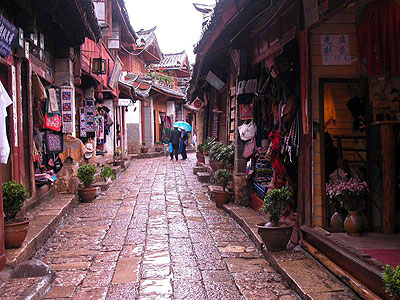
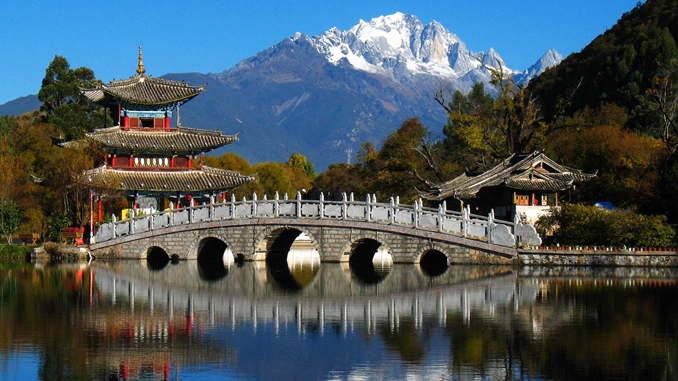
Bridges. There are 354 bridges in the town to deal with the convoluted water network. The styles are shelter bridge, stone arch bridge, slab bridge, and plank bridge. The famous bridges are Suocui Bridge, Dashi Bridge, Wanqian Bridge, South Gate Bridge, Saddle Bridge and Renshou Bridge, all built in Ming and Qing dynasties. Dashi Bridge, 100m from eastern Sifang Street, has a reflection on Jade Dragon Mountain.
The water network of Lijiang comes from Black Dragon Pool fuelled by numerous mountain springs that divide into the Central, Eastern and Western tributaries after heading to the Shuangshi Bridge. Every residence in the town is fed by this water network after it divides into conduits.
Shuangshi Pedestrian Bridge.
On the flight, there were clouds above the smog and eventually they cleared for dramatic views of the mountains and a river before reaching Lijiang. I caught the airport bus (20¥) and then a taxi to my hostel – October Inn. Waiting there was my debit card that had been forwarded from my hostel in Beijing. I love the security of having 2 of each.
In the hostel were 3 Australian girls excited about the Trans-Siberian Railway and seeing Mongolia and Russia in the winter. They have no idea what -35 is. Because she had endured +45 in Australia, she thought this would be no problem. They don’t realize that you don’t go outside in temperatures like that even if you have the proper clothes. And I doubt they have clothes that will deal with -10. There is very little romantic about the whole idea. It is called the Vodka Tour for a reason.
TIGER LEAPING GORGE

I caught the 07:45 bus from below my hostel. It was 2½ hrs to Qiaotou, I bought the trail pass (65¥) and the bus dropped me off at the bottom of the road where we started hiking. I will give detailed instructions for the trail: Head up the dirt road and after 5 minutes, angle left up the narrow paved road (unsigned) which soon rejoins the gravel road. After about 2.5kms, just past a lone guesthouse, the trail (unsigned again) starts up to the left. It climbs steeply up to a small overlook, and goes down to the main trail protected by a big fence. The trail then contours around the mountain with the main river below you. After 1¾ hrs, I reached a small village and Naxi’s GH. Continue, crossing two small roads, and start the climb that eventually gets to the bottom of Naxi’s 28 switchbacks. I was 3 hours, not counting breaks, to the top of the switchbacks. The drop is precipitous and the river can’t be seen from here.
The special thing about Tiger Leaping Gorge is not the trail or the Jinsha River, but the stupendous Haba Shan mountains across the valley. Jagged limestone cliffs, a few small glaciers and incised by water courses producing sharp ridges, they are stunning, especially later in the day when side-lit.
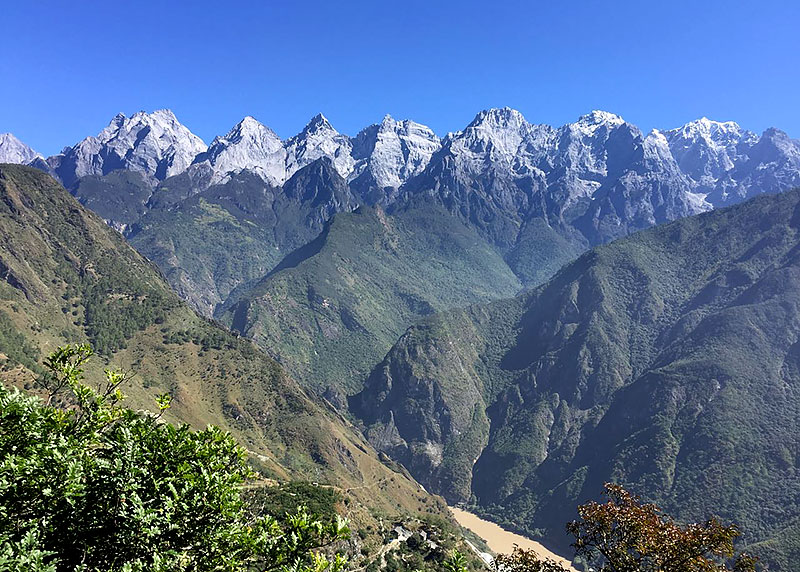
This is claimed to be one of the deepest canyons in the world measuring 3900m from the top of the mountains to the river. I have been to many other canyons making this claim: Copper Canyon in Northern Mexico, Colca Canyon in Peru, and the canyon on the east side of the Annapurnas in the Himalaya of Nepal – they all make the same claim but are all measured from the top of the surrounding mountains. None though compares with the Grand Canyon, a full mile down from the rim. That is what makes it so special – the distance straight down from the rim.
From the high point, descend and then contour to reach a ‘guest house village’ after 1 hour. Then walk on a road to again access the trail passing farmhouses (they grow corn here), a forest of ponderosa pine, rhododendron and cactus and great views down to the river. It is another hour to another ‘guesthouse village’ and Halfway Hostel. I was a little over 6 hours with breaks to here and was pretty knackered.

The hostel is in a spectacular setting with views across to the best of the mountains. I got a dorm room for 40¥. They also have great food. I would strongly recommend staying a night here rather than continuing down the 1½ hrs to Tina’s Guest House near the river. Unless you are a fast walker and take few breaks, it would almost be dark by the time you reach Tina’s. Save that last bit for the next morning. I brought a day pack with some warm clothes and a tooth-brush, so had little to carry.
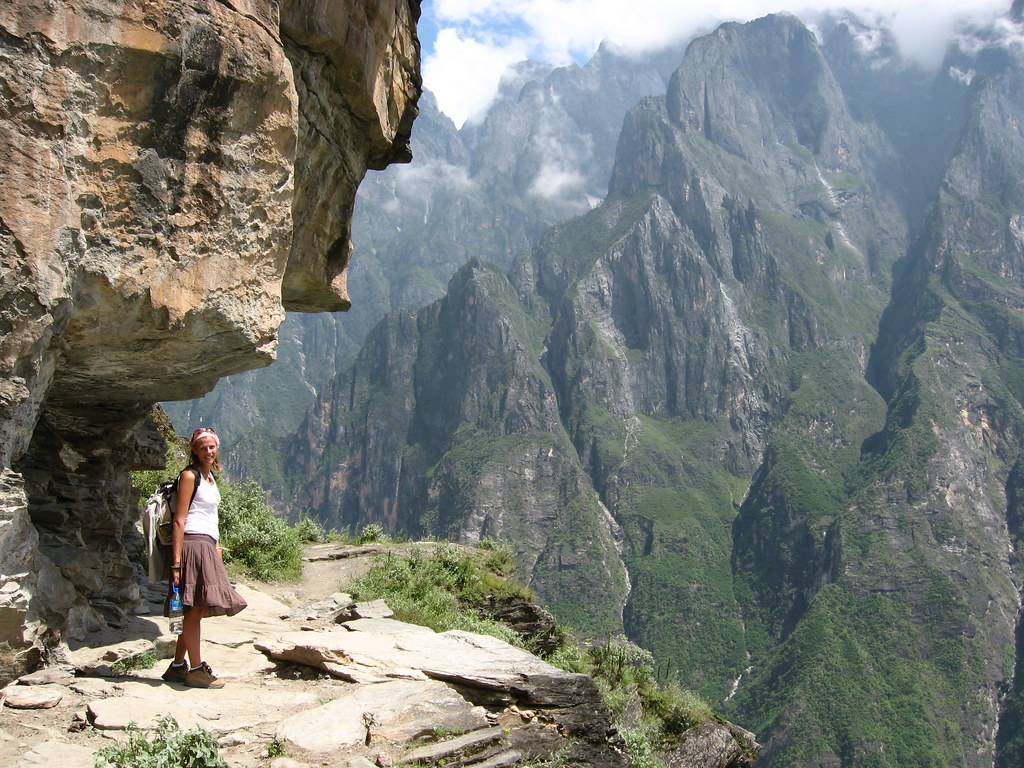
From Tina’s, it is possible to walk 2 hours to the village of Daju, or take a bus 3 hours to Shangri-la. With a magical name, it isn’t that magical. At 3200m, this Tibetan city is a typically ugly, medium-sized place with an ‘old town’ that sounds better. T virtually shuts down after October. However it can be the start of the rough 5-6 day journey through the Tibetan towns of Western Sichuan to Chengdu.
From Tina’s, it is a 40 minute walk down to the middle rapids and Tiger Leaping Stone (where a tiger is once said to have leapt across the river). A trail from here goes one hour to Walnut Garden. I didn’t bother with either of these and instead caught a mini-van (the regular bus doesn’t leave till 15:30) back to Qiaotou and a bus back to Lijiang. After arriving in Lijiang, I didn’t have a clue where I was, but after working my way through Old Town to the north side, I was able to find the stairs leading up to October Inn.
In my last evening in Lijiang, I went to a concert of classical Chinese music. A 29 piece orchestra with classical instruments played ‘old music” most more than 600 years old. Many in the orchestra were equally ancient – seven were over 80 with white hair (unusual to not dye hair here) and beards. Old Town Lijiang has winding cobble streets, canals and mostly reconstructed buildings. Scads of tourists shop in scads of souvenir shops and eat in the many restaurants.
NOMAD MANIA YUNNAN WEST
World Heritage Sites
Three Parallel Rivers of Yunnan Protected Areas lies within the drainage basins of the upper reaches of the Yangtze (Jinsha), Lancang (Mekong) and Nujiang (Salween) rivers, in the Yunnan section of the Hengduan Mountains across a region 180 km by 310 km. For a distance of over 300 km, three of Asia’s great rivers run roughly parallel to one another though separated by high mountain ranges with peaks over 6,000 meters. Then the rivers greatly diverge: the Nujiang River becomes Salween and empties at Moulmein, Burma, the Lancang becomes the Mekong and south of Ho Chi Minh City empties into the South China Sea and the Yangtze flows into the East China Sea at Shanghai. Selected nature reserves and places of scenic beauty in this unique region were collectively awarded World Heritage Site status in 2003 for their very rich biodiversity and outstanding topographical diversity.
Running parallel to these three rivers, but to the west inside Burma, is the river gorge of the N’Mai river, the main tributary to the Irrawaddy River.
Although this region has been acknowledged as a natural World Heritage Site, its demographic make-up also is highly interesting as it contains many of the twenty-five minorities found in Yunnan province including the Derung, the smallest of all of China’s minority groups. Some of the other minorities found in this region are the Tibetan people, the Nu people, Lisu, Bai, Pumi and Naxi. Many of these minorities still use traditional costumes as their normal daily attire. In the same region as the Three Parallel Rivers of Yunnan Protected Areas lies the Old Town of Lijiang, which is also a World Heritage Site in its own right.
Tentative WHS:
Ancient Tea Plantations of Jingmai Mountain in Pu’er (29/01/2013). A biodiversity hot spot, wild ancient tea trees, some 2700 years old, half wild-half cultivated ancient tea trees older than 1000 years and well preserved large ancient Pu’er tea plantations with tea trees of 100-1000 years old have been discovered in this area, located on the Jingmai Mountain in the southwestern border area of Yunnan Province.
In about 180 A.D., a branch of Blang, an ethnic minority group, discovered tea when migrating to the region of Jingmai, and tried to cultivate tea trees in the forest because of limited land and the climate and soil conditions favorable for tea trees. In the 3rd century, Blang people gradually mastered the tea cultivation techniques, and began to domesticate, cultivate tea trees and trade tea products, thus started the 1800 years’ history of tea cultivation.
The highest elevation is 1662 meters (Nuogang Mountain) and the lowest 1100 meters (Nanlang Valley). Ancient tea plantations are mainly distributed in the mountain area of 1250-1550 meters above sea, and concentrates in three areas: Manggeng-Mengben ancient tea plantations, Jingmai Dapingzhang-Nuogang ancient tea plantations and Mangjing ancient tea plantations. In a total area of 1870 hectares, there are about 1.13 million ancient tea trees, of which the oldest tea tree has a history of 1400 years. Less than 10% of the tea trees are aged500-1000 years, about 30% are 300-499 years old, and the average age of the tea trees in the entire biocenosis is about 200 years. The nominated area is not only the largest and the best-preserved ancient tea plantation area of the region, but also the largest ancient cultivated arbor tea plantation of the world.
XL:
Dali Bai
Dehong dai and Jingpo
Nujiang Lisu
Xishuangbanna (Sibsongbanna, or Sipsong Panna, shortened to Banna) is a Tai Lü autonomous prefecture in the extreme south of Yunnan. The prefectural seat is Jinghong, and straddles the Mekong. This region of China is noted for its distinct culture – the people, architecture, language, and culture more closely resemble those of the Shan, Dai and Tai (Thai and Lao) peoples.
DALI CITY is the major town of the Dali Bai Autonomous Prefecture in NW Yunnan. northwestern Yunnan. Xiaguan is the modern city centre where most long-distance transportation arrives. Dali Old Town is 10 km to the north of Xiaguan and is one of the most popular tourist destinations in Yunnan, known for its natural scenery, historical and cultural heritage, and vibrant nightlife.
Dali Chanshan Mountain and Erhai Lake Scenic Spot (29/11/2001). Tentative WHS.
Chong Shen Monastery
Bai Ethnic Villages. The Bai are one of the 56 ethnic groups officially recognized by the People’s Republic of China. They numbered 1,858,063 as of 2000. The Bai people hold the colour white in high esteem – Baip people literally means ‘white people’ in Chinese. 80% live in concentrated communities in the Dali Bai Autonomous Prefecture in Yunnan Province. An estimated 1,240,000 speak the Bai language and most adhere to Buddhism. Dress: favour white -women generally wear white dresses, sleeveless jackets of red, blue or black color, embroidered belts, loose trousers, embroidered shoes of white cloth, jewelry made of gold or silver. Women in Dali traditionally wear a white coat trimmed with a black or purple collar, loose blue trousers; embroidered shoes, silver bracelets and earrings. Unmarried women wear a single pigtail on the top of the head, while married women roll their hair. The men wear white jackets, black-collared coats, and dark loose shorts. Their headwear and costume reflect the Bai symbols: the snow, the moon, the flower, and the wind.
The modern Bai are famous for their tie dyes and use them for wall hangings, table decorations, clothing, etc. They use cormorants for fishing.
Bai architecture is characterized by three brick and wood buildings forming a U and a fourth wall as a screen of brick and stone. The house is painted in white with black tile paintings depicting animals and other natural images. Dali is well known for its marble. The name for marble is ‘Dali marble’ in Chinese. It is used in modern architecture by the Bai.
Heshun Town is an ancient town in 4kms SW of the city centre of Tengchong City and is well known for its quadrangle courtyards that have been built into the town’s hills.
Mount Jizu: Zhusheng Temple (Boyu’an) is a Buddhist temple located at the foot of Mount Jizu, in Binchuan County. In April 1984, it has been classified as a National Key Buddhist Temple in Han Chinese Area. The extant buildings include the Shanmen, Four Heavenly Kings Hall, Mahavira Hall, Hall of Medicine King, Hall of Dharma Protectors, Hall of Ksitigarbha, Guru Hall, Buddhist Texts Library, Meditation Hall, Drum tower, Bell tower, Dining Hall, abbot’s room.
The next morning I caught the 08:30 luxury bus 7 1/2 hours to Kunming. I had decided to bypass Dali, only 2 hours from Lijiang. The original funky banana-pancake backpacker hangout in Yunnan, it was the place to chill, with its stunning location sandwiched between mountains and a big lake. Loafing here for a couple of weeks was an essential Yunnan experience in the past. Even though it has been discovered by the Chinese tourist masses, it remains a reasonable relaxed destination. I am not yet in need of a few days off so will overnight in Kunming before continuing on.
KUNMING (pop 3 million), the capital of Yunnan, was the end point of the famous Burma Road that extended 1000kms to Lashio in Myanmar. It is known as the ‘Spring City” for its equable climate. Large numbers of young Westerners come here to study Chinese. There are few worthwhile sites and not much reason to stay, so I used it only as a transit hub.
It is so nice traveling independently when everything goes as planned – usually because of the help of Chinese. At the West Bus Station in Kunming, I refused the 50¥ taxi and took bus #80 (1¥) to the Railway Station. Many Chinese laugh at you when you struggle to get directions – go figure – but one nice young fellow with zero English reassured me I was on the right bus and he was going to the train station too. At the station, I went to the ticket counter (no lineups at #5 ticket wicket), the woman spoke perfect English and I had my hard sleeper, middle berth all the way to Guilin, a 24-hour ride via Nanning and virtually through the entire province of Guangxi (the most southerly province in China) for 270¥. It leaves at 16:00 giving most of the day to see Shilin. She told me where to find a hotel. The first place at 200¥ had no elevator, but the second had a room with an elevator but no bathroom for 129¥ ($21.50). The pleasant young woman at the desk used Bing translate and I found everything I needed to know. I had a nice supper on the street, found the bus stop to the East Bus Station for the morning, bought all the stuff for breakfast in my room and retired to my budget, but clean room. And by doing it on the cheap, I obtained a huge amount of satisfaction and saved 167¥ ($28) on the room and two avoided taxi rides. How good can it get?
Shilin and the Stone Forest. About 120km southeast of Kunming, this place is equal parts tourist trap and natural wonderland in a setting of stunning karst geology. A massive collection of grey limestone pillars are split and eroded by wind and rainwater (the tallest is 30m high). The sense of nature gets lost with not a piece of dirt anywhere – lush grass extends to the base of each pillar, stone walkways meander everywhere through the stunning pillars and there are millions of people. Walking on the paths can be impossible and the grass can be the only way to move (you don’t ever walk on grass in China). The parking lot was filled with hundreds of tour buses, how 99.99% of people arrive here. To escape the hordes of tourists, arrive early, avoid weekends and take the secluded walks outside the central area of karst.


The tall rocks seem to arise from the ground in a manner somewhat reminiscent of stalagmites, or with many looking like petrified trees, thereby creating the illusion of a forest made of stone. Since 2007, two parts of the site, the Naigu Stone Forest and Suogeyi Village, have been UNESCO World Heritage Sites as part of the South China Karst.
I was up at 5, at the bus stop at 6 to go to the Kunming East Bus Station on the far outskirts of town, and on the bus to Shilin at 7. It takes 2 hours from Kunming. The crowds beat me here.
World Heritage Sites:
Chengjiang Fossil Site is noted for soft-tissue fossil finds, of the Maotianshan Shales, dated less than 518 million years ago during the Cambrian explosion, which “are as spectacular as the Burgess Shale fauna, and significantly older.” These fossils are considered one of the most important fossil finds of the 20th century. They contain an exquisite degree of detail, cover a diverse range of fauna, and are significant in attempts to understand the evolution of life on Earth.
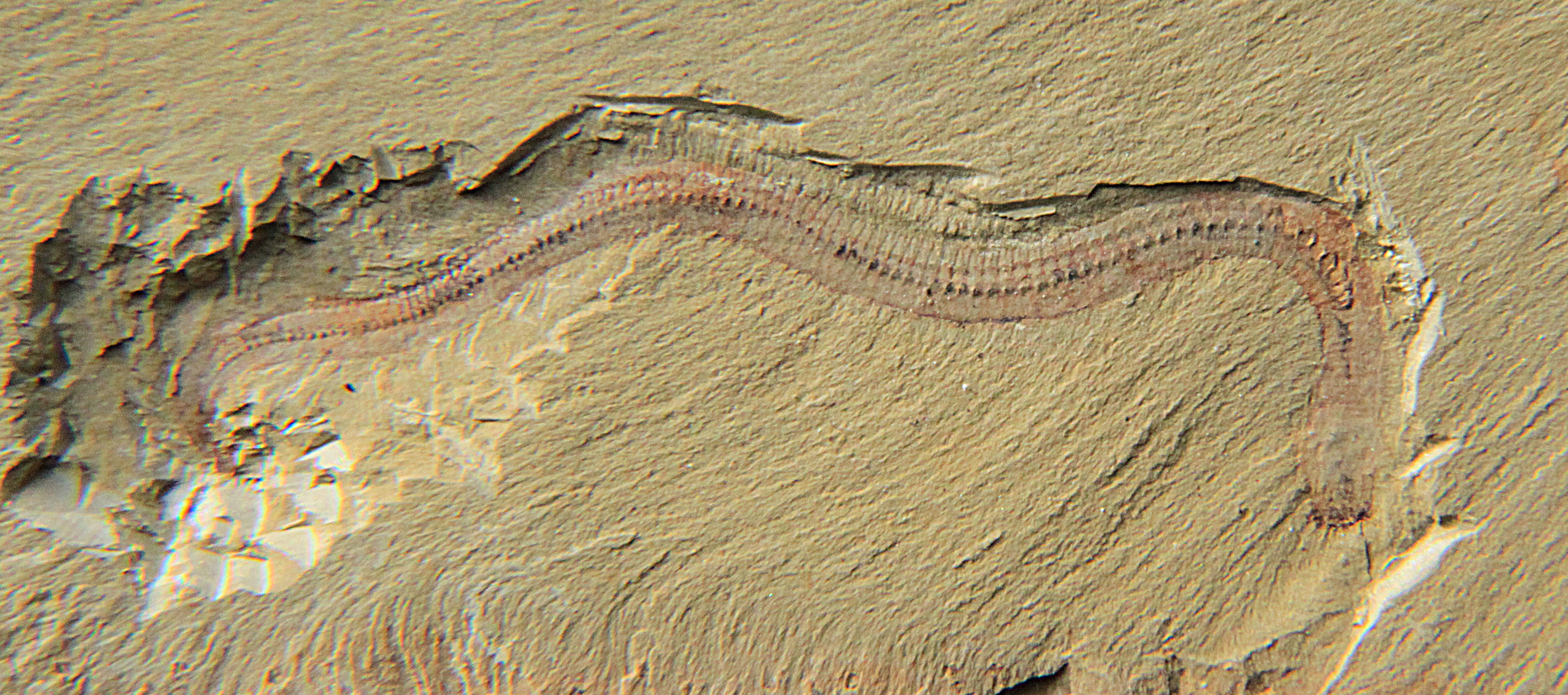
Cultural Landscape of Honghe Hani Rice Terraces are the system of Hani rice-growing terraces located in Honghe Prefecture, Yuanyang County, Yunnan. The terraces’ history spans around 1,200 years. The total area measures 1,000,000 acres. In 2013, the Honghe Hani Rice Terraces were listed as a World Heritage Site.

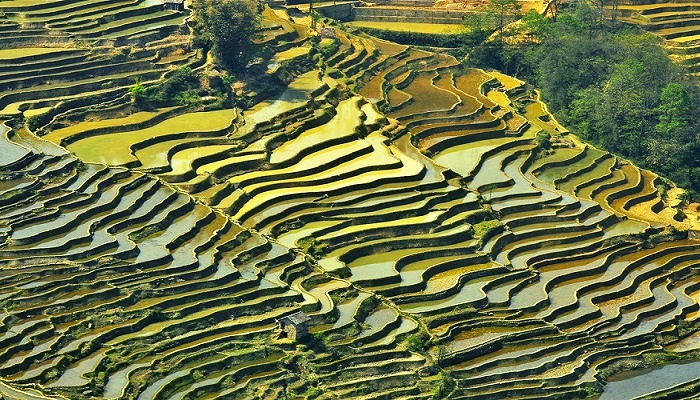
Chuxiong Yi
Degen Tibetan
Honghe Hani and Yi
Wenshan Zhuang and Miao
Yunnan Nationalities Museum
Yunnan Provincial Museum
Yunnan Railway Museum
Huating Temple is a Buddhist temple located in Xishan District of Kunming,
Qiongzhu Temple (Bamboo Temple) is a Buddhist temple situated on Yu’an Mountain NW of Kunming. It was established during the Yuan dynasty as the first temple dedicated to ZenBuddhism in Yunnan. It has since been burned down and reconstructed several times. The present structure mostly dates from the late Qing dynasty. The temple is most renowned for the painted clay sculptures of the 500 Buddhist arhats.
Yuantong Temple is the most famous Buddhist temple in Kunming. It is located in a protected natural depression and in recent years it has been expanded with funding from Thailand. In the 1950s, it hosted a grand ceremony to greet and send on the sacred teeth of the Buddha and so became important in Southeast Asia.
It was first built 8-9th centuries with major restorations and expansion in the Chenghua period (1465-1487) of the Ming dynasty and in 1686 during the reign of the Kangxi Emperor in the Qing dynasty, the temple took on its present design, with covered corridors, bridges and grand halls.
Dwarf Empire (Kingdom of the Little People) is a theme park located near Tadelandia that features comic performances by people with dwarfism. Supporters of the park claim that it provides employment to people who would otherwise be unable to find work, but it has been criticized for treating dwarfism as a humorous condition.
As of 2010, there were over 100 employees whose ages ranged from 19 to 48. The park requires employees to be less than 51 inches (130 cm) tall. The employees live in nearby dormitories which were specifically constructed to be accessible to short people. During the performances, the actors pretend to live in small mushroom shaped houses.
The park is part of a complex in the western suburbs of Kunming that also includes the World Butterfly Ecological Park. Although many visitors to the park are students from nearby towns, but wants is to be a tourist destination. He provides English lessons for his employees to help them interact with foreign tourists. He aims to eventually employ 1,000 people with dwarfism. Rice Terraces consists of Duoyishu Rice Terraces, Huangcaoling Rice Terraces, Aichun Rice Terraces and Pugaolao Village, etc. At the altitude of 1900 meters, it is marked by spectacular terraces that cascade down the slopes of towering Aliao Mountain to the banks of the Hong River. The scenic area is the best place to appreciate and shoot the sunrise, cloud sea and the village.
Most time of the year, the rice terraces here are lost in the cloud and mist. the best place to appreciate sunset. During the sunrise, the scenery with changeable colour reflected in the water, spectacular terraces and villages appearing indistinctly is so fantastic that it seems as if you are in a fairyland.
The best season to visit Honghe Hani Rice Terraces is from November to next April because the terraces are in irrigation period at that time. After the autumn harvest, the rice paddies will be filled with water. During this period, the morning glow and sunset glow reflect on the water and the rice terraces turn into golden. In the spring, cattle and the local Hani people are working in the rice fields, and the whole rice terraces turn into green.
Caves: Jiu Xiang Caves
I took the train 18 hours from Kunming to Guilin in the far NE of Guangxi Province.
